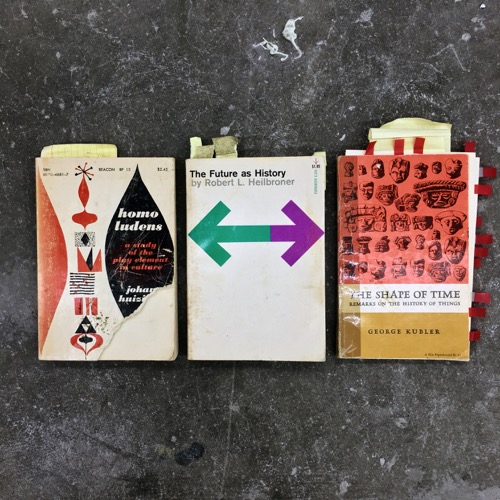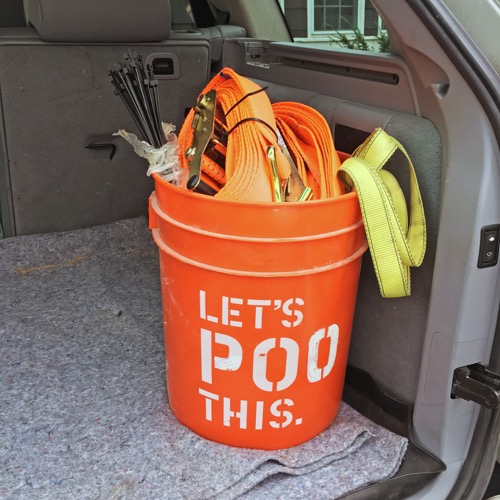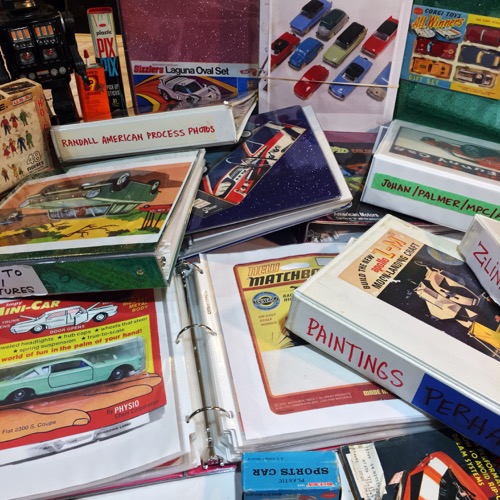Randy Regier, Artist

Cool Tools Show 277: Randy Regier
Our guest this week is Randy Regier. Randy is an artist living and working in Kansas City, Kansas. Randy has lived on both coasts over his life but has settled in the middle because it’s a good place to live on the least amount of money in order to make the most amount of things. You can find Randy on Instagram @rand.regier, @tipo_american_art, and @the_gongfarmer_cartoon.
Subscribe to the Cool Tools Show on iTunes | RSS | Transcript | See all the Cool Tools Show posts on a single page
Show notes:

Tools_01: Three books I have had for almost 20 years to which I never tire of returning to and sampling: The Shape Of Time by George Kubler, Homo Ludens by Johan Huizinga, and The Future As History by Robert L. Heilbroner
One thing that’s sort of profound about these three books is that each time I return to them, I’m not the exact same person and I have a different experience reading them. I see things in there that maybe I missed or wasn’t ready to read the first time. One of the things in my experience and from my point of view in making is we maybe don’t speak about play as much as I wish we did or it’s devalued. Play is considered something that’s done when we’re not being serious about lives. I find play to be a reason for living. Without play, I don’t know why I would even want to be here. I take play very seriously and at the same time it’s fragile and it can be very brief and it’s beautiful. Homo Ludens by Johan Huizinga is just a really elegant look into what the real value of play is — in animals, in humans, and what have you. All of these books are modernists. They’re ancient by contemporary standards in the sense that a lot of people feel that we’ve moved beyond these writers. The Future as History by Robert Heilbroner is profound in that I would urge people to read it now that are having difficulty with the current times, which may be a majority of persons thinking that is all rather new series of events, the degradation of the American Dream. One of the most profound things in this book was he talks about the American experience as sort of based on this notion of eternal optimism, which no other nation in the world was part of their DNA. Yeah, so the books, one could be under the impression looking at them that the reason I have them is for the covers, which would be reason enough, actually, as I didn’t actually buy them for those covers. I bought them for the titles and I’ve read them and a couple of them I’ve read two or three times, but it’s like they say you can’t step into the same river twice.

Tools_02: A Makita 18 Volt Drill/Driver
I use this tool constantly. It is light, powerful, ergonomic and with the led light — it’s so fine you can’t borrow it. With some tools, the more you use them the more you realize they just enable you to just be so wildly productive when you have the good fortune to be in a really productive groove and things are going and where I have these ideas that I can’t wait to make manifest. There’s X amount of hours in the day and the right tools are the things that enable me to realize my best intentions, so it’s large words or it’s sort of a profound statement to try to apply to a Makita drill/driver. I use that thing for so many different processes. What’s the old phrase? “The hammer forms the hand?” Where the right tool can lead you to be more competent. A really quality tool can improve you as a human and your capacities. I really feel that way about that drill. It fits my hand beautifully. It’s got that wonderfully thoughtful LED light, which I’m still geeking out on and I’ve had that for 10 years. I can’t believe that I live in a time in human history where you can have an electric drill without a cord on it and a light built in.

Tools_03: A five gallon bucket full of tie down straps, bungie cords and zip ties.
This bucket lives in my car and allows me — any time I see some free potential object against the curb, buy some damned thing or am given some large (useable) donor object — to get them home in the least Grapes of Wrath way. The tie-downs, the bungee cords, the zip ties, those things are absolutely invaluable because I use a predominance of found objects in my work. My toys are not made out of toy parts. They’re made out of found objects or the guts of found objects. When we lived in Wichita that was a pretty good picking ground. It’s a city that’s had a lot of aircraft industry over the years. A lot of cottage industries, and you drive by these old businesses and they’d be timed out, so this stuff would be shoved out in the back or out to the street. I built a piece out of a 1949 Kelvinator refrigerator. A 1949 Kelvinator refrigerator was built by the Nash Automobile Company, and so it’s got all of these automotive motifs and it’s stamped steel. It’s a piece I built Celestial Mechanic out of, which is at the Ulrich Museum. Any rate, so here’s this refrigerator that has got this fantastic amount of parts and potential, all of these stamped steel and these chrome medallions and the structures. Well, if you’re going to drag that thing home, you got to tie it down depending on what you have to drive. I mean, that’s a pretty big object, but there’s other things that I will see or people will give me things. For God’s sake, people give me too much stuff, but their intentions are good. Sometimes they get these things, they’re just awkward and they’re too big for the vehicle. We drive this little old Mazda car. I don’t even have a van these days, and so I try to jam these things into the trunk of this car, and then the tie-downs make it possible for me to get that old thing home with the least amount of humiliation.

Tools_04: A library of three-ring binders of scores of color copies of vintage toy packaging and book illustrations (scanned or web sourced), either for historical reference and/or to check the predominant color palette, verbiage and style of any given era.
Almost every toy-themed piece or series I begin starts with leafing through these binders seeking the image that I most want to emulate, distill, parody and/or celebrate next. I’m a big fan of books on paper and I consume a lot of imagery when I do a lot of research. One of the things that attracts me the most to being an active artist is that I love researching. It’s a form of archaeology. How do you find the thing? Where is the thing that you wish to find? What else will you find when you’re there? In this era of the web that we live, there is an unending rainfall of images … that was Umberto Eco, I think, that said that. I find these images of these really rarefied or lovely mid-century toy packages, model kit boxes, toys from all over the world. These are not objects that are available to me and they’re not the kind of thing that anyone has really sought to do a really beautiful series of coffee table books about. But the only way I have access to them is through the internet. I want them as studio materials, as images, because I really pour over them. I’ll go to Google image search. I’ll hit images. I’ll go to my tools and I’ll hit large so I get a big enough image that I can print on an 8.5 x 11 piece of paper. I make my own books. I never tire of looking through those. I’ll look at those images and it’ll be boxes that were done by French manufacturers and English and Americans and Japanese. You know, those are real illustrators, real people painting those paintings, and so you look at those toy boxes and you can see how they were trained to create the effect of window glass or the reflection off of a chrome. It’s just an endless source of fascination for me and I can’t go into an art museum and get that information.
About Raise the ToyGantic:
I’m quite fond of Raise the ToyGantic, a short film that the LA based Gail Lerner made a few years ago using my toy sculptures throughout as key agents of the narrative. I was able to be around the set for much of the filming and it was just a grand experience. She made a really lovely film out of the whole endeavor. Gail had seen my work a number of years ago, and when she was in Maine and when we were there we crossed paths. In 2015, she made a 26-minute-long short film based on a key piece of mine, an eight-foot-long toy ocean-liner that I built, sunk it in a lake, and then a year later went back, brought out of the lake and presented it as if I’d found it and had uncovered the entire history of it as a line of large toy ships that sunk. That was an incredible experience because for me, what it did was I tend to leap from one piece to another like someone jumping across a creek, jumping from stone to stone, not thinking that those stones have a relationship to each other. The pieces that she used in that film, I never thought of them as being part of a narrative. They were each independent sort of standalone things that pointed at this or that or the other conceptually. When she made that film, in a way she gave my work back to me more dimensional, more connected, and more meaningfully than I had ever imagined myself.
We have hired professional editors to help create our weekly podcasts and video reviews. So far, Cool Tools listeners have pledged $390 a month. Please consider supporting us on Patreon. We have great rewards for people who contribute! If you would like to make a one-time donation, you can do so using this link: https://paypal.me/cooltools.– MF
05/7/21





